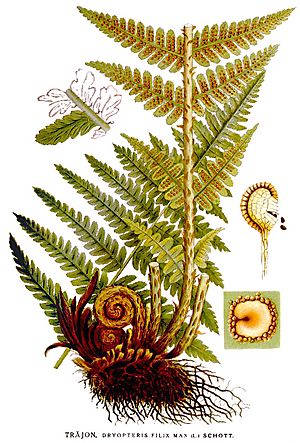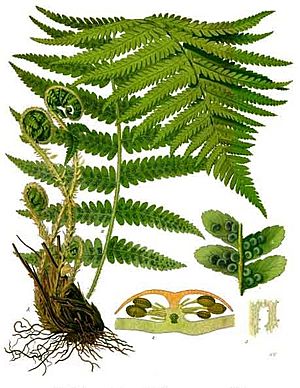Male fern facts for kids
Quick facts for kids Male fern |
|
|---|---|
 |
|
| Conservation status | |
| Scientific classification | |
| Genus: |
Dryopteris
|
| Species: |
filix-mas
|
The male fern, known scientifically as Dryopteris filix-mas, is a very common fern. You can find it in many cool parts of the Northern Hemisphere, including Europe, Asia, and North America. This fern loves damp, shady spots, especially under trees in woodlands. It also grows well in shady places on rocky areas or along hedge-banks. In colder regions, it sometimes prefers sunny, well-drained spots. While it's super common in Europe, it's a bit harder to find in North America. Long ago, people sometimes called it "worm fern" because they used it to treat tapeworms.
Its scientific name, filix-mas, actually means "male fern." Filix means "fern" and mas means "male." People thought it was the "male" version of another fern, the Lady fern (Athyrium filix-femina). This is because the male fern looks very strong and grows vigorously.
Discovering the Male Fern: Description
The male fern has leaves that stay green for most of the year, making it semi-evergreen. These leaves grow upright and can reach up to 150 centimeters (about 5 feet) long! Each fern plant has a single cluster of leaves growing from its root.
Each large leaf is made up of 20 to 35 smaller leaf sections called pinnae on each side of the main stem, or rachis. The leaf gets narrower at both ends. The pinnae near the bottom are about half the size of the ones in the middle. The very small leaflets, called pinules, are somewhat rounded and have small, even lobes all around. The stems of the leaves are covered with fuzzy, orange-brown scales.
On the underside of a mature leaf, you'll see 5 to 6 clusters of spores, called sori, arranged in two rows. When the spores are ready to be released, usually from August to November, the protective covering (called an indusium) shrivels up. This allows the tiny spores to float away and start new ferns.
Sometimes, the male fern can naturally mix its genes with other types of ferns. It can create hybrid plants with the Scaly male fern (Dryopteris affinis) and the Dryopteris oreades (mountain male fern).
Growing and Using the Male Fern
Many special types of male ferns, called cultivars, have been chosen for gardens. These are ferns that gardeners have specifically grown for their unique looks. Several of these cultivars have even won an award called the Royal Horticultural Society's Award of Garden Merit. This award means they are excellent plants for gardens.
Some of the popular male fern cultivars include:
- D. filix-mas (the regular male fern)
- 'Crispa Cristata'
- 'Cristata'
- 'Grandiceps Wills'
- 'Linearis Polydactyla'
As mentioned earlier, in ancient times, the male fern was used as a traditional medicine. People believed it could help get rid of tapeworms.
See also
 In Spanish: Helecho macho para niños
In Spanish: Helecho macho para niños



